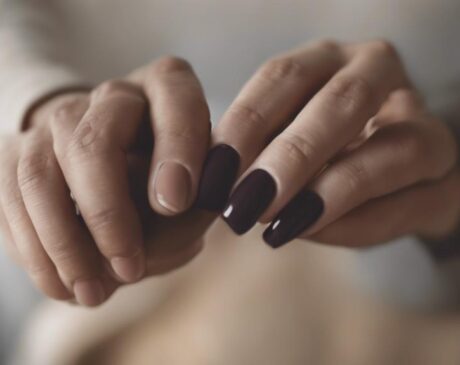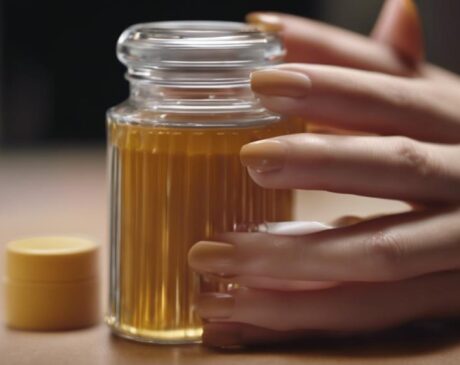What Happens if You Dont Cure Gel Nail Polish?
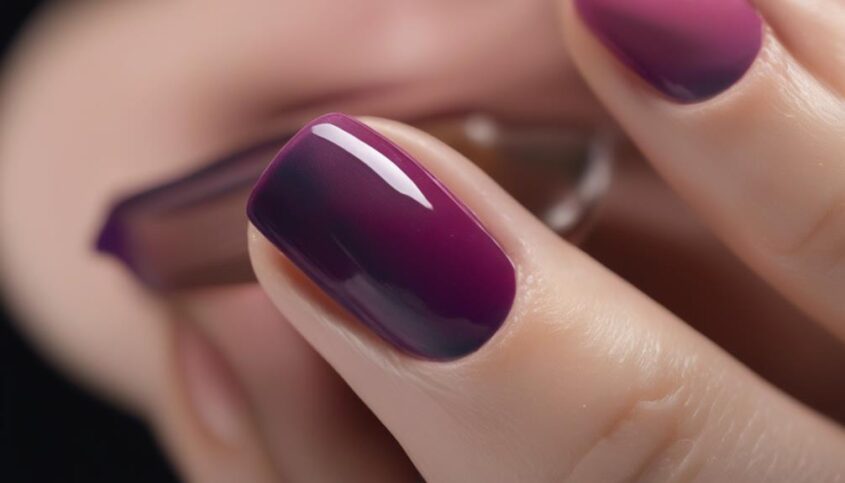
Improperly curing gel nail polish leads to decreased longevity and durability of the manicure. It can cause chipping, peeling, and adhesion issues, making the nails vulnerable to damage from water and wear. Wrinkling, bubbling, and texture problems may occur without proper curing. Incomplete polymerization affects the quality, leaving the gel sticky and prone to damage. Loss of glossy finish, increased susceptibility to damage, and difficulty in removal are other consequences. Ensuring proper curing techniques is essential to maintain the integrity of gel nail polish. Learn more about the impacts of neglecting gel nail polish care.
Key Takeaways
- Decreased longevity and durability without proper curing.
- Risk of chipping, peeling, and adhesion issues increases.
- Potential for wrinkling, bubbling, and texture problems.
- Incomplete polymerization leads to quality concerns.
- Loss of glossy finish and increased susceptibility to damage.
Decreased Longevity of Manicure
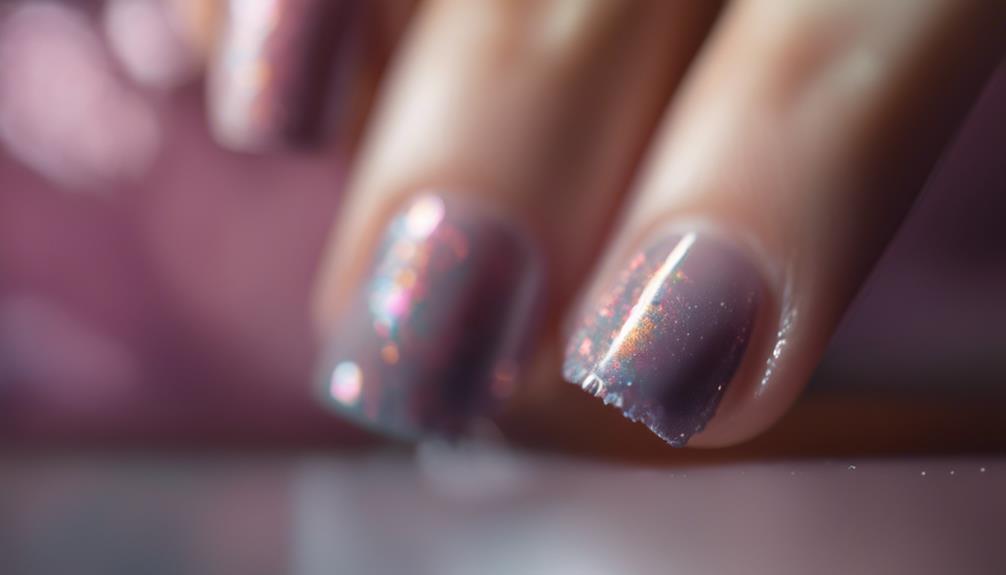
If gel nail polish is not properly cured, the longevity of the manicure will be significantly reduced. Proper curing is crucial for gel nail polish to bond securely to the nail surface, ensuring a durable and long-lasting finish. Inadequate curing can lead to premature chipping, peeling, or fading of the polish, ultimately diminishing the overall quality of the manicure.
When gel nail polish is not fully cured, it remains vulnerable to external factors such as water, heat, and daily wear and tear. This vulnerability compromises the integrity of the manicure, making it more prone to damage and requiring more frequent touch-ups or repairs. Additionally, uncured gel polish may not achieve its full potential in terms of shine, color vibrancy, and resistance to fading over time.
To maximize the longevity of your gel manicure, it is essential to follow proper curing procedures diligently. Investing in high-quality gel nail products and ensuring adequate curing time under a UV or LED lamp will help maintain a flawless and enduring manicure that withstands the test of time.
Risk of Chipping and Peeling
Improper curing of gel nail polish increases the susceptibility to chipping and peeling, compromising the durability of the manicure. When gel polish is not correctly cured, the layers may not bond adequately, leading to weakened adhesion between the polish and the nail surface. This weakened bond makes the manicure more prone to chipping, especially at the tips and edges of the nails where the stress on the polish is highest. Additionally, peeling can occur when the gel polish is not fully cured, causing layers to separate prematurely.
Furthermore, inadequate curing can result in an uneven surface, making the nail polish more prone to catching on objects and lifting away from the nail. This not only affects the aesthetic appeal of the manicure but also increases the risk of further chipping and peeling. Proper curing techniques are essential to ensure the longevity and integrity of gel nail polish manicures, reducing the risk of chipping and peeling.
Potential for Wrinkling and Bubbling
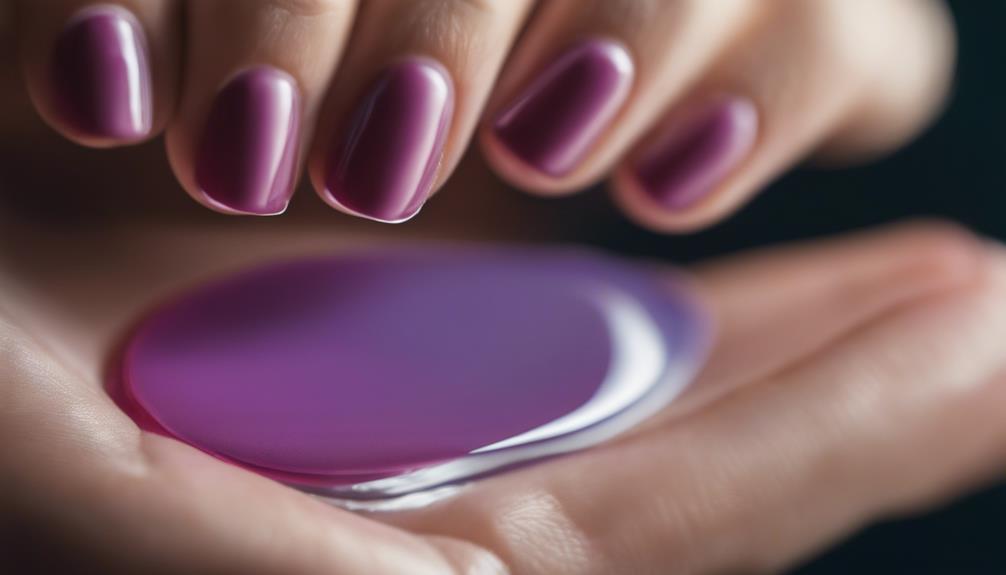
Failure to properly cure gel nail polish can lead to potential issues such as wrinkling and bubbling. When the gel polish is not adequately cured, it may result in a wrinkled appearance on the nails. Additionally, incomplete curing can cause bubbling, affecting the overall smoothness and finish of the manicure.
Wrinkling Risk With Uncured Gel
The application of gel nail polish requires meticulous curing to mitigate the risk of wrinkling and bubbling. Uncured gel polish poses a significant threat to the flawless finish of your manicure. Here are some key points to understand this risk:
- Insufficient exposure to UV/LED light can lead to incomplete polymerization.
- Incomplete polymerization results in unstable layers that are prone to wrinkling.
- The lack of proper curing time can cause bubbles to form within the gel polish.
- Wrinkling can occur if the gel layer is too thick and not fully cured.
- Bubbling is more likely to happen when the gel is applied too thickly and not cured evenly.
Bubbling Issues Without Cure
Experiencing bubbling issues in gel nail polish can result in potential complications such as wrinkling and uneven texture. Bubbles trapped within the uncured gel polish can prevent it from adhering smoothly to the nail surface, leading to a bumpy finish. When the gel polish is cured with bubbles present, it can create pockets of air that cause wrinkling as the product hardens. Additionally, the uneven distribution of gel due to bubbling can result in an inconsistent texture that is both unattractive and may compromise the durability of the manicure. To avoid these issues, ensuring a bubble-free application and proper curing process is essential for achieving a flawless and long-lasting gel nail finish.
Incomplete Gel Polish Curing
Insufficient curing of gel nail polish can lead to issues such as wrinkling and bubbling, affecting the overall quality and longevity of the manicure. When gel polish is not adequately cured, the chemical reaction necessary for a durable finish is compromised, resulting in unsightly flaws. To understand the implications better, consider the following:
- Inconsistent Texture: Incomplete curing can lead to a mixture of hard and soft layers, affecting the polish's smoothness.
- Prone to Chipping: Weakly cured gel polish is more likely to chip or peel prematurely.
- Lack of Shine: Improper curing may result in a dull or matte appearance instead of a glossy finish.
- Color Distortion: The color of the polish may appear altered or less vibrant if curing is inadequate.
- Difficult Removal: Properly cured gel polish is easier to remove without damaging the natural nail.
Incomplete Polymerization of Gel
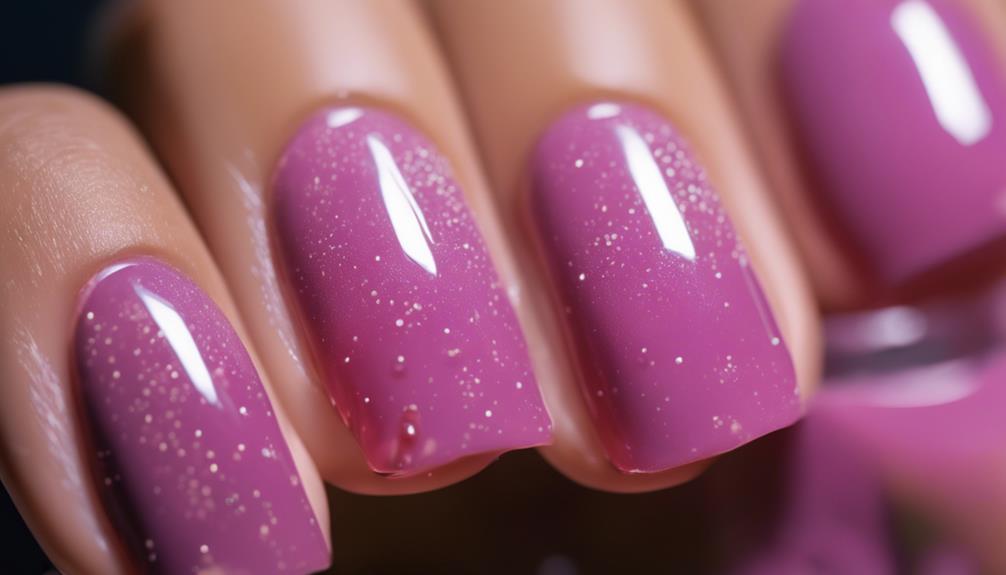
Incomplete polymerization of gel nail polish can lead to several issues, including the gel remaining sticky even after curing, the color fading prematurely, and the nails becoming more prone to chipping. When the gel polish does not fully polymerize, it compromises the durability and longevity of the manicure, affecting both the aesthetic appeal and the overall quality of the nail treatment. Ensuring proper curing is essential to achieve the desired hard, glossy finish that gel nail polish is known for.
Gel Remains Sticky
Inadequate curing time can result in gel nail polish remaining sticky due to incomplete polymerization of the gel. This incomplete polymerization can lead to various issues that affect the quality and durability of the gel manicure. To understand the implications better, consider the following points:
- Adhesion Problems: Incomplete polymerization can cause poor adhesion between the gel and the nail surface.
- Softness of the Gel: The gel may remain soft and pliable, making it prone to damage.
- Lack of Shine: Inadequate curing can result in a dull finish lacking the glossy shine.
- Increased Vulnerability: Sticky gel is more susceptible to smudging and collecting dust and lint.
- Shortened Lifespan: A gel manicure that stays sticky is likely to peel or chip sooner, reducing its longevity.
Color May Fade
The diminished vibrancy of the gel nail polish color may result from a lack of thorough polymerization during the curing process. Incomplete polymerization can lead to a faded appearance of the nail color over time, causing dissatisfaction among those seeking long-lasting and vibrant gel manicures. This issue arises when the gel nail polish is not adequately exposed to the curing light, preventing the molecules from bonding fully and resulting in a weakened color saturation. To combat this, ensuring proper curing time and technique is essential to achieve the desired hue longevity. By addressing the polymerization process diligently, users can enjoy extended wear of their gel nail polish without compromising on the richness and intensity of the chosen color.
Prone to Chipping
When gel nail polish undergoes insufficient polymerization, it becomes more susceptible to chipping, compromising the durability and longevity of the manicure. Incomplete polymerization can lead to various issues, including:
- Weakened Bonding: Inadequate curing weakens the bond between the gel polish and the natural nail.
- Surface Imperfections: Unpolymerized gel can result in an uneven surface that is prone to chipping.
- Increased Vulnerability: The nails are more exposed to external factors like water and chemicals.
- Shortened Lifespan: The manicure may not last as long as expected due to premature chipping.
- Aesthetic Concerns: Chipping can affect the overall appearance of the nails, detracting from the desired aesthetic.
Loss of Glossy Finish
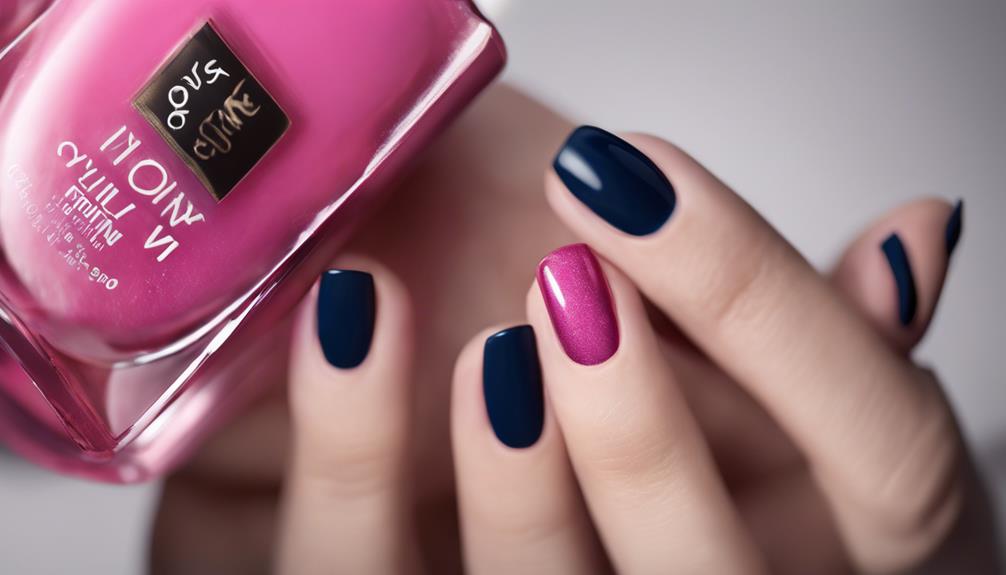
Over time, the gel nail polish may lose its glossy finish, appearing dull and lackluster. This loss of shine can detract from the overall aesthetic appeal of the manicure, leaving the nails looking less vibrant and polished. The once glossy and reflective surface may become matte or cloudy, diminishing the visual impact of the nail polish color.
Several factors can contribute to the loss of the glossy finish in gel nail polish. Exposure to harsh chemicals, such as cleaning agents or acetone, can strip away the topcoat's shine. Additionally, prolonged sun exposure or frequent hand washing can also dull the glossy appearance of the nails over time.
To combat the loss of glossiness in gel nail polish, it is essential to take proper care of your manicure. Using cuticle oil regularly can help maintain the moisture balance in the nails and prevent them from becoming dry and dull. Applying a fresh layer of topcoat periodically can also restore the glossy finish and prolong the longevity of your gel manicure.
Increased Susceptibility to Damage
What implications arise from neglecting the proper care of gel nail polish, leading to an increased susceptibility to damage? When gel nail polish is not properly cured and maintained, it can result in a higher vulnerability to various forms of damage.
- Chipping: Gel nail polish that is not fully cured is more prone to chipping, which can quickly ruin the overall look of the manicure.
- Peeling: Inadequately cured gel polish can lead to peeling, causing the polish to lift off the nail prematurely.
- Cracking: Without proper curing, gel polish is more likely to crack, creating an unsightly appearance.
- Weakening: Neglected gel polish may weaken the nails over time, making them more susceptible to breakage.
- Staining: Improperly cared for gel polish can cause staining on the natural nail, leading to discoloration that is difficult to remove.
To avoid these issues and maintain healthy, long-lasting gel manicures, it is crucial to follow the proper curing and maintenance procedures.
Difficulty in Removal Process
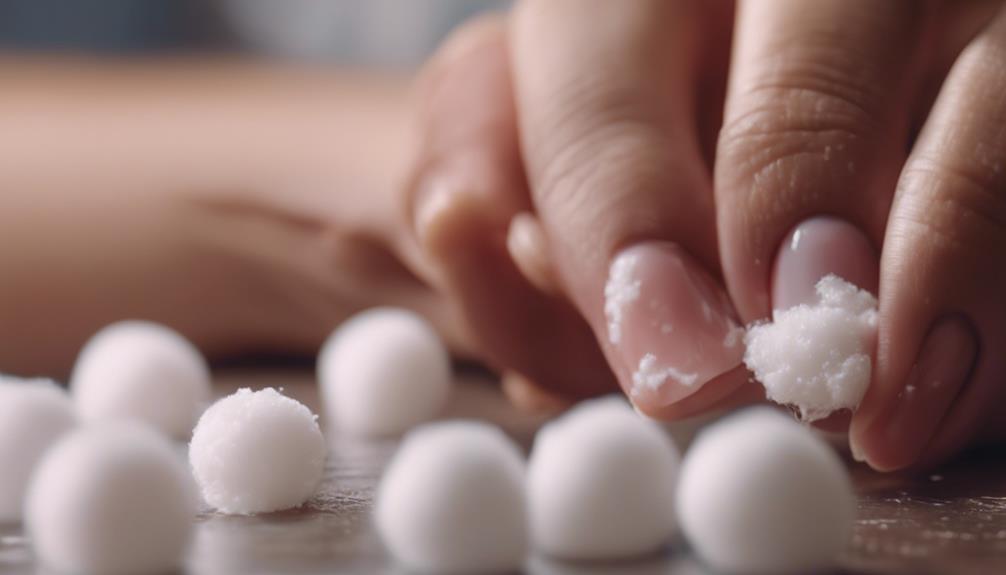
Neglecting proper care of gel nail polish and allowing it to remain uncured can significantly contribute to the difficulty in the removal process. When gel polish is not properly cured, it does not bond as securely to the nail, making it resistant to removal methods. This leads to a stubborn adherence that necessitates prolonged exposure to removal agents, potentially causing harm to the nail bed and surrounding skin. The incomplete curing process can result in the polish becoming thick and hardened, further complicating the removal procedure.
The enhanced hardness of incompletely cured gel polish makes it more laborious to break down and remove, requiring extended soaking in acetone or filing that can weaken the natural nail. Moreover, the risk of chipping or peeling during removal increases, leading to potential damage to the nail surface. Therefore, ensuring proper curing of gel nail polish is paramount to facilitate an efficient and safe removal process, preserving the health and integrity of your nails.
Frequently Asked Questions
Can Not Curing Gel Nail Polish Lead to Long-Term Damage to My Natural Nails?
Not curing gel nail polish properly can result in poor adhesion, leading to premature chipping and peeling. Long-term neglect may weaken natural nails due to repeated applications without proper curing, potentially causing damage if not addressed.
Is There a Risk of Developing an Infection if Gel Nail Polish Is Not Properly Cured?
Properly curing gel nail polish is vital to prevent the risk of developing an infection. Incomplete curing may create a breeding ground for bacteria, leading to potential health concerns. Following manufacturer instructions for curing is key for optimal results.
How Does Incomplete Polymerization of Gel Nail Polish Affect the Overall Look and Durability of the Manicure?
Incomplete polymerization of gel nail polish compromises its durability and appearance. This hinders adhesion, causing chipping and peeling. The manicure's longevity is significantly reduced, leading to a subpar finish that fails to meet expectations for a professional and polished look.
Are There Any Potential Health Risks Associated With Not Curing Gel Nail Polish?
Incomplete curing of gel nail polish can lead to potential health risks as uncured chemicals may cause skin irritation or allergic reactions. Proper curing is essential for ensuring the safety and longevity of gel manicures.
Will Not Curing Gel Nail Polish Affect the Overall Appearance of My Nails in the Long Run?
Neglecting to cure gel nail polish properly may result in a lackluster appearance over time. Inadequate curing can lead to chipping, dullness, and a shortened lifespan of the manicure. Ensuring proper curing is essential for long-lasting and vibrant nails.

